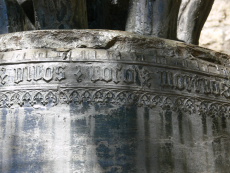
‘Mortuos Plango, Vivos Voco,’ is a landmark piece of music composed by Jonathan Harvey in 1980. The title is in Latin, and roughly translates to, ‘I lament the dead: the living I call to prayer.’ Although the title initially seems odd, and indeed, why have it in Latin, when most people do not know the language, but the instrumentation and composition, I believe, can explain this seemingly unusual choice. Stanley Haynes and Xavier Rodet aided Harvey in making the piece, and the piece itself was actually commissioned by cultural centre in Paris, the Centre Georges Pompidou.
The primary technique used to create this piece is known as multi-tracking. This was a technique originally developed in 1955, and was revolutionary at the time, as it meant that music could be created in a whole different way. Essentially, it enabled multiple sounds to be recorded at the same time, from individual sources, which had never been done before. So although this method was not new in 1980, Harvey used it in a very creative way.
Ultimately, Harvey’s piece includes only two sounds; the sound of the Bell at Winchester Cathedral – one of the oldest and largest Cathedrals in Europe – and the voice of Harvey’s son. From the Bell, we can see how the title was chosen; not only is Latin befitting of an archaic yet important Bell, but there is an inscription on the Bell itself, which reads, ‘Horas Avolantes Numeros, Mortuos Plango, Vivos ad Preces Voco,’ which means, ‘I count the fleeing hours, I lament the dead: the living I call to prayer.’ On top of these two components, Harvey used a computer programme named Music V to further analyse and manipulate the sounds to create his desired effect.
Winchester Cathedral’s Bell has a range of notes, but the Bell is in essence ‘tuned’ to produce a C sound, and from that, subsequently creates many notes in the series of F harmonics. Harvey recorded the sounds of the Bell and ‘dissected’ it, isolating smaller sounds from the ringing of the bell, and thus had multiple sounds to play with, and with different tonality and density and a sense of richness. Throughout the piece, it sounds as though Harvey has begun with a ‘larger’ Bell, and then eventually ends up using a much ‘smaller’ Bell, though, in reality, it is the same Bell for the whole piece.
To actually make the piece, Harvey did a similar thing with recordings of his son’s voice; recording it and again dissecting it into smaller sections so as to edit it further and segregate as small sounds as possible for a wider range. Following this break down, Harvey does something very innovative, which is In part, what makes the piece so very striking; he attempts the merge the two ‘voices’ into one. Very cleverly, Harvey places the Bell sounds on the track with the voice of his son, in such a way, that it goes from being completely obvious which voice is which, to it being almost impossible to distinguish which voice is which, as the resonances blur together in a very beautiful, but also somewhat eerie way.
Overall, I think Harvey’s piece is a very interesting piece due to how he has put the track together, and also due to the instrument choices. It is so monumental due to its innovation through composition techniques and arrangement and is worth a listen to on that basis.
Image:https://de.wikipedia.org/wiki/Wetterläuten

0 Comment:
Be the first one to comment on this article.